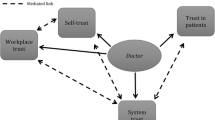Abstract
Trust is one of the central features of patient-physician relationships. Rapid changes in the health care system are feared by many to be threatening patients’ trust in their physicians. Yet, despite its acknowledged importance and potential fragility, rigorous efforts to conceptualize and measure patient trust have been relatively few. This article presents a synopsis of theories about patient trust and the evolution of methods to measure it. Clinicians, educators, and researchers interested in this area may find this information useful in practice and teaching. The gaps identified in our knowledge about trust can help target new efforts to strengthen the methodological basis of work to understand this vital element of medical relationships.
Similar content being viewed by others
References
Mechanic D, Schlesinger M. The impact of managed care on patients’ trust in medical care and their physicians. JAMA. 1996;275:1693–7.
Kao AC, Green DC, Zaslavsky AM, Koplan JP, Cleary PD. The relationship between method of physician payment and patient trust. JAMA. 1998;280:1708–14.
Emanuel EJ, Dubler NN. Preserving the physician-patient relationship in the era of managed care. JAMA. 1995;273:323–9.
Mechanic D. Changing medical organization and the erosion of trust. Milbank Q. 1996;74:171–89.
Gray BH. Trust and trustworthy care in the managed care era. Health Aff (Millwood). 1997;16:34–49.
Luhman N. Trust and Power. New York, NY: John Wiley & Sons; 1989.
Barber B. The Logic and Limits of Trust. New Brunswick, NJ: Rutgers; 1983.
Gambetta D. Trust: Making and Breaking Cooperative Relations. Oxford, UK: Basil Blackwell; 1988.
Kramer RM, Taylor TR, eds. Trust in Organizations: Frontiers of Theory and Research. Thousand Oaks, Calif: Sage; 1996.
Lewis JD, Weigert A. Trust as a social reality. Social Forces. 1985;3:967–85.
Baier A. Trust and antitrust: trust and its varieties. Ethics. 1986;96:231–60.
Gurtman MB. Trust, distrust, and interpersonal problems: a circumplex analysis. J Pers Soc Psychol. 1992;62:989–1002.
Anderson LA, Dedrick RF. Development of the Trust in Physician Scale: a measure to assess interpersonal trust in patient-physician relationships. Psychol Rep. 1990;67:1091–100.
Thom DH, Campbell B. Patient-physician trust: an exploratory study. J Fam Pract. 1997;44:169–76.
Caterinicchio RP. Testing plausible path models of interpersonal trust in patient-physician treatment relationships. Soc Sci Med. 1979;13A:81–99.
Mechanic D. The functions and limitations of trust in the provision of medical care. J Health Polit Policy Law. 1998;23:661–86.
Goold SD. Money and trust: relationships between patients, physicians, and health plans. J Health Polit Policy Law 1998;23:687–95.
Safran DG, Kosinski M, Tarlov AR, et al. The Primary Care Assessment Survey: tests of data quality and measurement performance. Med Care. 1998;36:728–39.
Kao AC, Green DC, Davis NA, Koplan JP, Cleary PD. Patients’ trust in their physicians: effects of choice, continuity, and payment method. J Gen Intern Med. 1998;13:681–6.
Grumbach K, Selby JV, Damberg C, et al. Resolving the gatekeeper conundrum: what patients value in primary care and referrals to specialists. JAMA. 1999;282:261–6.
Cleary PD, Edgman-Levitan S, Roberts M, et al. Patients evaluate their hospital care: a national survey. Health Aff (Millwood). 1991;10:254–67.
Thom DH, Bloch DA, Segal ES. An intervention to increase patients’ trust in their physicians. Acad Med. 1999;74:195–8.
Safran DG, Taira DA, Rogers WH, Kosinski M, Ware JE, Tarlov AR. Linking primary care performance to outcomes of care. J Fam Pract. 1998;47:213–20.
Ware JE Jr., Hays RD. Methods for measuring patient satisfaction with specific medical encounters. Med Care. 1988;26:393–402.
Wolf MH, Putnam SM, James SA, Stiles WB. The Medical Interview Satisfaction Scale: development of a scale to measure patient perceptions of physician behavior. J Behav Med. 1978;1:391–401.
Brazier JE, Harper R, Jones NM, et al. Validating the SF-36 health survey questionnaire: new outcome measure for primary care. BMJ. 1992;305:160–4.
Jenkinson C, Coulter A, Wright L. Short form 36 (SF36) health survey questionnaire: normative data for working adults. BMJ. 1993;306:1437–40.
Author information
Authors and Affiliations
Corresponding author
Rights and permissions
About this article
Cite this article
Pearson, S.D., Raeke, L.H. Patients’ trust in physicians: Many theories, few measures, and little data. J GEN INTERN MED 15, 509–513 (2000). https://doi.org/10.1046/j.1525-1497.2000.11002.x
Issue Date:
DOI: https://doi.org/10.1046/j.1525-1497.2000.11002.x




